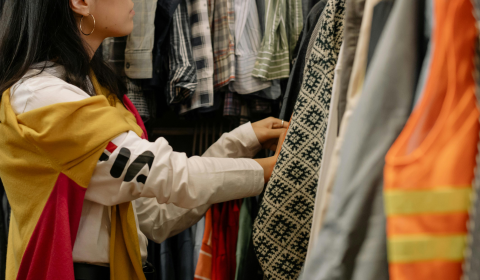The luxury brand’s brush with accusations of paedophilia has united haters and fans in shared concern. But the controversy also points to systemic issues of exploitation and power within the fashion industry.
Publicity stunt? Mindless oversight? Elite satanic conspiracy?
Whichever best explains Balenciaga’s latest controversy – triggered by two campaigns that featured disturbing associations between children and sex – finding an answer to the whole fiasco has become somewhat of a moot point in the face of its subsequent fallout.
For anyone who hasn’t been following, Balenciaga – a luxury clothing brand headed by Georgian fashion designer Demna – launched a gifting campaign on Instagram last week.
The images, since deleted, featured young children dressed head-to-toe in Balenciaga clothing, standing amidst a slew of designer gifts. But it wasn’t the monogrammed tea sets or custom yoga mats that drew attention.
What’s really riled people up are the teddy bear backpacks the kids are clutching, which appear to be wearing bondage belts and fetish clothing.
Whether you’re a fan of the brand, a fervent hater, or simply uninterested, we can all agree the bags were inappropriate for children.
Garish PR stunts are nothing new in the fashion industry, and one also couldn’t be blamed for assuming Balenciaga may simply have made a (very stupid) marketing blunder.
But as Raven Smith put it, ‘the idea that a cabal of paedophiles is trying to […] and normalise the sexualisation of kids via a Balenciaga campaign feels – dare I say it – a little far-fetched?’.
Yet shortly following bear-gate, another campaign sparked outrage. Featuring notable celebrities including Bella Hadid and Nicole Kidman in a high-rise office setting, the images were called out for the inclusion of brow-raising paperwork on the office desks.
After some sleuthing, one netizen found a page from the 2008 Supreme Court ruling in United States v. Williams, which confirms child pornography as illegal and not protected by freedom of speech.
Needless to say, Balenciaga has received some well-deserved heat for both campaigns.
While I’m certain the brand didn’t have some grave child-pornography-centred agenda behind its latest collections, nor do I believe the heads of the company are evil predators.
But the response to Balenciaga’s blunder – both from the public and Balenciaga itself – has said more about fashion’s twisted power structures than the campaigns ever could.
Despite removing the images and sharing an apology note to Instagram shortly after backlash started to surface, Balenciaga has decided to – very publicly – seek $25 million in damages from production company North Six, who shot both campaigns.
Set designer Nicholas Des Jardins has also been targeted in the lawsuit.
This ferocious reaction not only adds fuel to the whole controversy fire – after all, I’m sure there are just a handful of people who truly believe Balenciaga pushed this disgusting narrative on purpose, and such a public lawsuit feels a touch high-handed – but the brands deflection of blame has now raised another string of criticisms.
Demna, Balenciaga’s head designer, has been lauded for his creative genius since arriving at the brand’s helm.




















